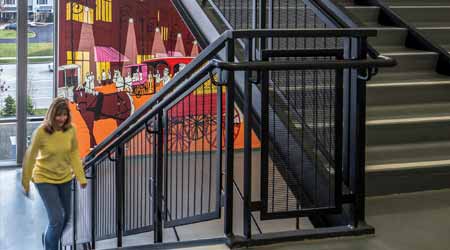 Promoting physical activity through design can encourage movement. The American Greetings headquarters outside of Cleveland has centralized the stairways and visible circulation paths to get employees up and moving.© CallisonRTKL/David Whitcomb
Promoting physical activity through design can encourage movement. The American Greetings headquarters outside of Cleveland has centralized the stairways and visible circulation paths to get employees up and moving.© CallisonRTKL/David WhitcombWELL and Fitwel Rating Systems Focus on Health and Wellness Outcomes
These new LEED-like rating systems focus on how happy, capable, and productive the indoor environment makes occupants feel.
Building on the popularity of LEED, purveyors of other programs are examining and quantifying the performance of an environment in terms of human outcomes. This approach frames the built environment in terms of how happy, capable, and productive it makes us feel. WELL is a relatively new system that focuses on design and architectural elements, as well as the associated effects on humans, and lays out a foundation for supporting human wellness through design and operations.
WELL is a holistic, easily scalable standard. While it began as a workplace-based system, its use has expanded to cover all project types and sizes. WELL is made up of ten concepts: air, water, nourishment, light, movement, thermal comfort, sound, materials, mind, and community. Each concept addresses a different issue and its implications on well-being, providing multiple ways to address wellness in a space. WELL goes beyond traditional sustainability standards and addresses more than green materials or physical activity: The breadth of issues addressed in the standard allows organizations to consider things like employee mental health and interpersonal interaction.
Projects are certified under WELL in much the same way as they are under LEED, although WELL projects must be recertified every three years to ensure sustained compliance. WELL also requires third-party verification on many features, ensuring that project features are correctly implemented to continue supporting occupant health.
In addition to WELL, Fitwel has gained popularity as a relatively low-cost implementation to introduce wellness concepts and promote physical well-being through design and operations. Fitwel is less holistic than WELL, but the standard is user-friendly and easy to implement across a variety of project types.
Fitwel covers seven health impact requirements: impacts community health, reduces morbidity and absenteeism, supports social equity for vulnerable populations, instills feelings of well-being, provides healthy food options, promotes occupant safety, and increases physical activity. Projects are self-scored by the project team, and projects are awarded between one and three stars depending on the number of points achieved. While Fitwel certification is not as intensive as WELL certification, the system is a useful tool for supporting occupant health, and it demonstrates a growing movement to consider human impacts of design and operations.
Related Topics:















